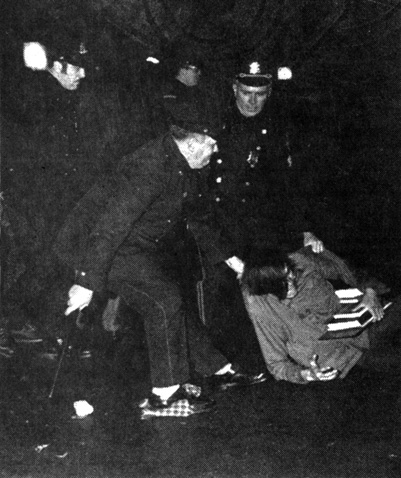 Photo Courtesy Boston Globe On January 29, 1970, 19-year-old Malcolm Emory, a student studying physics on a full scholarship at Northeastern University in Boston, Massachusetts, left the campus library after studying for a Russian mid-term exam. The University Quadrangle was jammed with about 3,000 students demonstrating against the war in Vietnam.
Emory was curious because he had never personally seen a protest. As he looked on, clutching an armload of books, Boston police charged into the crowd to break up the demonstration, and a melee erupted. Officer Vincent P. Logan arrested Emory because, according to Logan, Emory had a brick in one hand and a concrete block in the other and threw the brick, striking him in the chest.
After being treated for cuts on his arm and getting stitches in his head, chin and elbow, Emory was charged with assault and battery with a dangerous weapon on a police officer. He went on trial before a jury in May 1970. Logan testified that Emory had hit him with the brick and that he responded by striking Emory with his baton to subdue him.
Emory testified that he did not have a brick or concrete block in his hands and that he was carrying his books after studying at the library. He said that Logan initially came up behind him and struck him in the back of the head with his nightstick, yelling, “You spit at me!” When Emory protested that he had not, Logan hit Emory again. Emory fell to the ground, still clutching his books. Emory testified that after he was arrested, he was handcuffed and confined facedown with other arrestees in a university building where he was kicked and beaten by other police officers. His blood-stained Russian textbooks were introduced into evidence in his defense.
Logan denied seeing any books and said he only struck Emory after being hit with the brick. A Suffolk County jury convicted Emory and he was sentenced to six months in jail, which was suspended, and three years probation.
Emory’s scholarship, which he had received from the U.S. Navy, was revoked. He was forced to resign from his job at the United States Naval Underwater Sound Laboratory and he was stripped of his security clearance.
A native of Ledyard, Connecticut, Emory moved to West Virginia to live with friends. Hampered in his efforts to find work by his felony conviction, Emory worked a series of jobs as an apple-picker, welder and a tool and die fabricator. He later lived in California, where he learned underwater welding, and then Houston, Texas, where he performed the craft.
His conviction was upheld on appeal.
In 1985, Emory took a job in a machine shop in Peabody, Massachusetts. While visiting friends in Boston, he went to the Boston Library to look at microfiche of the front page of the Boston Globe newspaper for January 30, 1970, the day after he was arrested. Emory saw himself, barely visible, in a photograph accompanying an article about the demonstration. His books were obscured, however. Emory decided to see if the newspaper had other photographs of the demonstration that would show him carrying the books and support his claim of innocence.
After contacting the Globe, Emory discovered that the photographer who shot the photographs of the demonstration and melee was still working for the newspaper. Emory learned that there were more photographs of the event that had never been published. News media organizations almost uniformly refuse to divulge unpublished photographs without a subpoena. Emory faced a dilemma: He could not get a subpoena without filing a motion for new trial, yet without evidence of innocence, he could not file a motion for new trial. He asked the Globe to be allowed to view the photographs to see if there were others in which he could be seen and explained how he believed a photograph could exonerate him.
In January 1989, after years of negotiating with Emory’s attorneys, the Globe allowed Emory to view the unpublished images without a subpoena. On a contact sheet, he found an image of himself being dragged away by police, still clutching his books.
Armed with the photograph, Emory filed a motion for a new trial and a hearing was held. On April 6, 1990, the motion was granted. On May 24, 1990, the Suffolk County District Attorney’s office dismissed the case. The following day, Northeastern University, where Emory had been taking night classes since returning to the Boston area, granted Emory a full scholarship to complete his studies. In 1991, Emory graduated with a bachelor’s degree in physics.
In 1992, Logan pled guilty to accepting bribes to overlook liquor law violations and was sentenced to 90 days in jail.
Emory filed a state malicious prosecution lawsuit against Logan and on April 8, 1994, a jury awarded him $250,000 in damages.
– Maurice Possley |